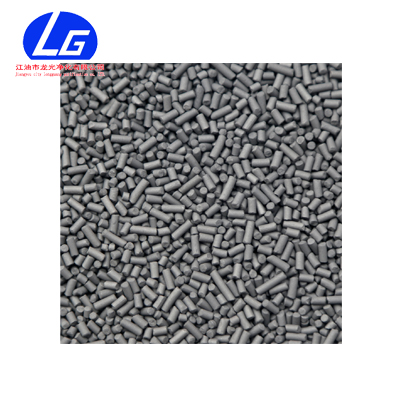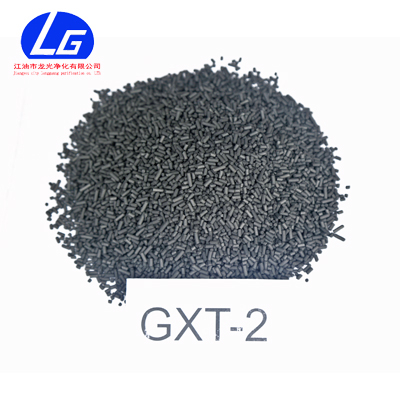Parameters:
Product parameters |
Product name | MODEL | Name of Project | Unit | Indicator | Remark |
Modified activated carbon defulfurizer | GXT-2 | color |
|
| black |
Spec. | Mesh | 100 |
|
Bulk density | kg/L | 0.5~0.65 |
|
Specific surface area | m2/g | 1000~1200 |
|
Pore volume | mL/g | 0.4~0.5 |
|
Wear rate | ﹪ | <3 |
|
Working sulfur capacity | ﹪ | ≥15 | Aerobic environment |
breakthrough sulfur capacity | ﹪ | ≥20 | Aerobic environment |
Lateral pressure strength | N/cm2 | ≥70 |
|
Removal rate of hydrogen sulfide | ﹪ | >90 |
|
Working Pressure | Mpa | 0~5 |
|
Temperature during use | ℃ | 0~60 |
|
Airspeed | h-1 | 1000~2000 |
|
Height-diameter ratio |
| >3 |
|
Defulfurization Mechanism
The desulfurization mechanism of activated carbon is to accelerate the process of the following reaction of the H2S and O2 in the gas with the catalytic action of the surface activity genes of activated carbon:
2H2S+O2------2H2O+2S ΔH=-434.3kJ/mol
Actually, the reaction between H2S and O2 on the surface of activated carbon is carried out in two steps: first, the activated carbon absorbs oxygen at its surface to form activated oxides on the surface; then the H2S molecules in the gases react with the adsorbed oxygen to produce sulfur, which is deposited on micropores of the activated carbon. To accelerate the reaction and improve the desulfurization efficiency, the actual ratio of O2/H2S should be larger than the theoretical value of 0.5, and the preferable value of the ratio is 3.
Active metals such as copper, alkali metals and alkaline earth metals can be introduced into the activated carbon desulfurizer by impregnation to make the activated carbon modified and its catalyzing efficiency improved.
Transport and Storage
1. The desulfurizer is packaged in laminated woven bags lined with plastics to prevent leakage, breakage, moisture absorption and chemical contamination.
2.For the purpose of transportation and handling, rolling, collision, high pressure and violent vibration, throwing and trampling should be avoided to prevent the product from being pulverized.
3.Rain-proof and moisture-proof measures should be taken for storage and transportation.
4. The product is classified as non-hazards, but relevant regulations or rules should be adhered to for its storage and transportation.
Precautions:
Filling Method
(1) Remove the dust by sifting prior to filling: No residual dust of waste desulfurizer is allowed in the desulfurization tower. A free fall of more than 0.5 meters is not allowed in filling, and the desulfurizer should not be trampled by personnel. If people is required to enter the furnace to fill, a cushion wood board should be laid on the desulfurizer
(2) Lay a layer of about 80 mm, φ15-20 mm ceramic balls; lay two layers of metallic screens with mesh size smaller than 4 mm on the ceramic balls; then fill the desulfurizer on the metallic screens. After filling, lay a layer of metallic screen on the the desulfurizer; and finally, press with ceramic balls on the desulfurizer to prevent the it from being blown away by the gas.
Start-up procedure
(1)Blowing the dust off the desulfurizer and replacement of the system
The blowing gas may be air or feed gas. If air is used, a charge gas replacement system should be employed, and only when the composition at the outlet and the inlet is the same, the replacement is considered to be up to standard.
(2) Pressure boost
In the pressurization system, the pressure should be boosted gradually. Increase the pressure by 0.1 MPa in every two minutes until the operation pressure is reached. After pressure boost, proceed half-load production for 1-2 hours to adjust the pressure and flow, etc. Once the operation is stable, increase the load gradually to enter normal production.
(3) Regeneration
When the H2S at the outlet of the desulfurization tower exceeds the specified value, the furnace should stop for regeneration
Procedures for regeneration:
① Cut off the feed gas, close the inlet valve, reduce the pressure by 0.1 MPa in every 2 minute till the pressure inside the tower returns to normal ambient pressure; then, close the outlet valve to isolate the desulfurization tower from the production system.
② Open the air release valve on the top of the tower.
③ Open the inlet hole at the bottom of the tower (or open the intake valve for regeneration), the desulfurizer will re-generates slowly under the natural ventilation conditions. To speed up the regeneration rate, pump in compressed air and control the temperature of the tower appropriately:the temperature should not exceed 60℃, with peak value not exceeding 80 ℃; otherwise the sulfur will sublime and burn spontaneously, causing damage to the desulfurizer and other equipment. It is considered the regeneration process has finished when the bed temperature stops rising and the oxygen content at both the inlet and outlet is the same basically.
(4) Stop running
Temporary stop: Close the inlet valve, outlet valve, and maintain the pressure. If the system leaks, charge gas should be used to maintain the pressure to prevent the occurrence of negative pressure in the system.
Stop for replacement of the desulfurizer: Stop per procedures for regeneration, then unload the desulfurizer.
NOTES
1. As the new desulphurizer is low in strength, it should be handled with care. For high desulfurization tower, it should be loaded in layers with each about 2~3 meters. While in service, avoid by all means the sharp rise of pressure; otherwise, the desulfurizer will pulverize due to effect of stress; and it is forbidden to soak the desulfurizer in water, which may greatly decrease the strength of the desulfurizer.
2. At least two temperature measuring points should be provided in the desulphurization tower to facilitate the observation of the temperature in the regeneration process. Once there are signs of over temperature, measures should be taken to avoid damages to the desulfurizer and the equipment.
3.Desulphurizer can be replaced completely at one time according to the actual circumstances; or be replaced layer by layer along the direction of the air flow.
 Current location:Home - Product Center - Activated carbon desulfurizer - GXT-2 Modified Activated Carbon Desulphurizer
Current location:Home - Product Center - Activated carbon desulfurizer - GXT-2 Modified Activated Carbon Desulphurizer




 Sales hot-line:0816-3736605
Sales hot-line:0816-3736605 E-mail:jysongwei@126.com
E-mail:jysongwei@126.com Address:No. 772, Laojun Road, Jiangyou, Sichuan
Address:No. 772, Laojun Road, Jiangyou, Sichuan

 QQ
QQ Tel
Tel Message
Message Share
Share Top
Top